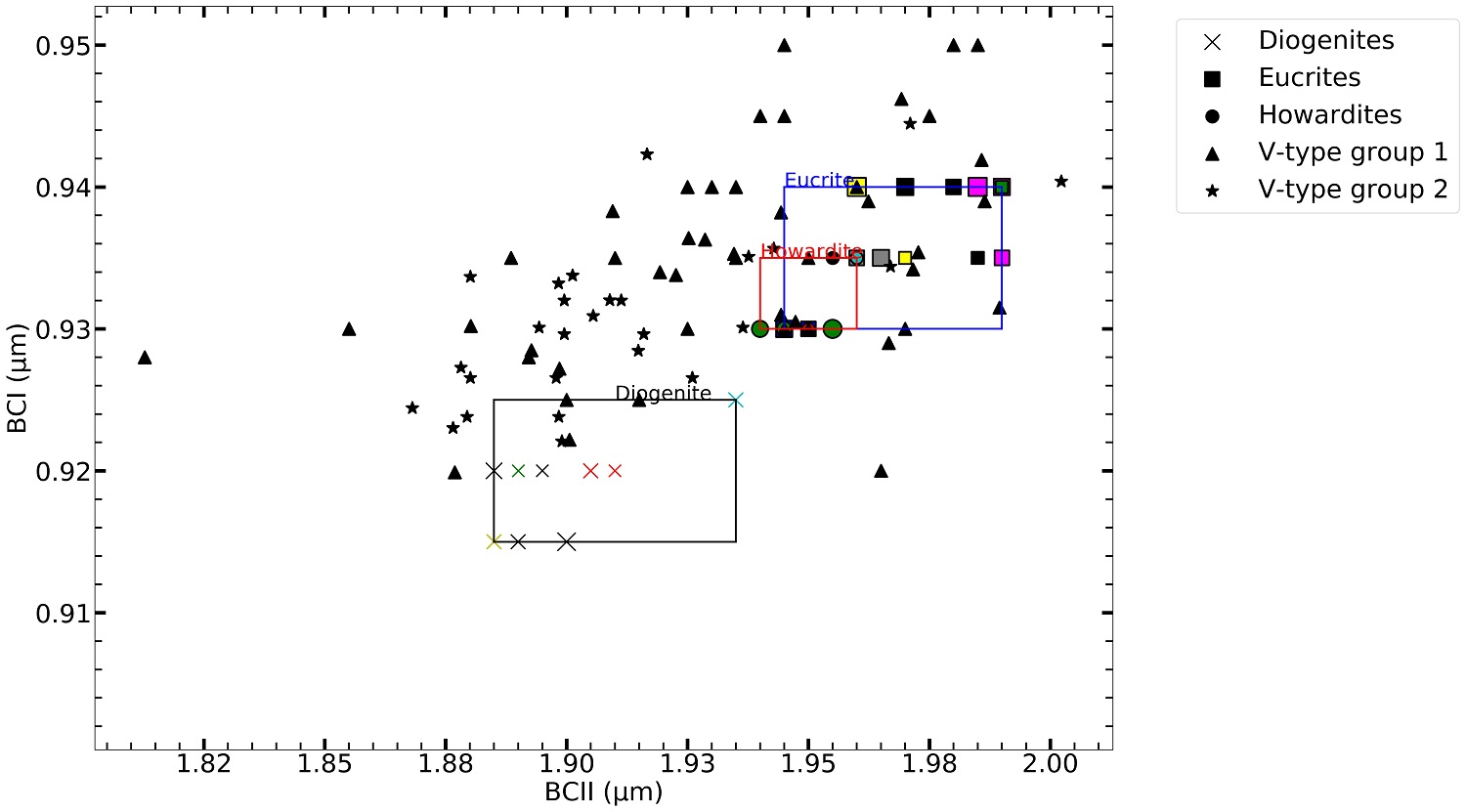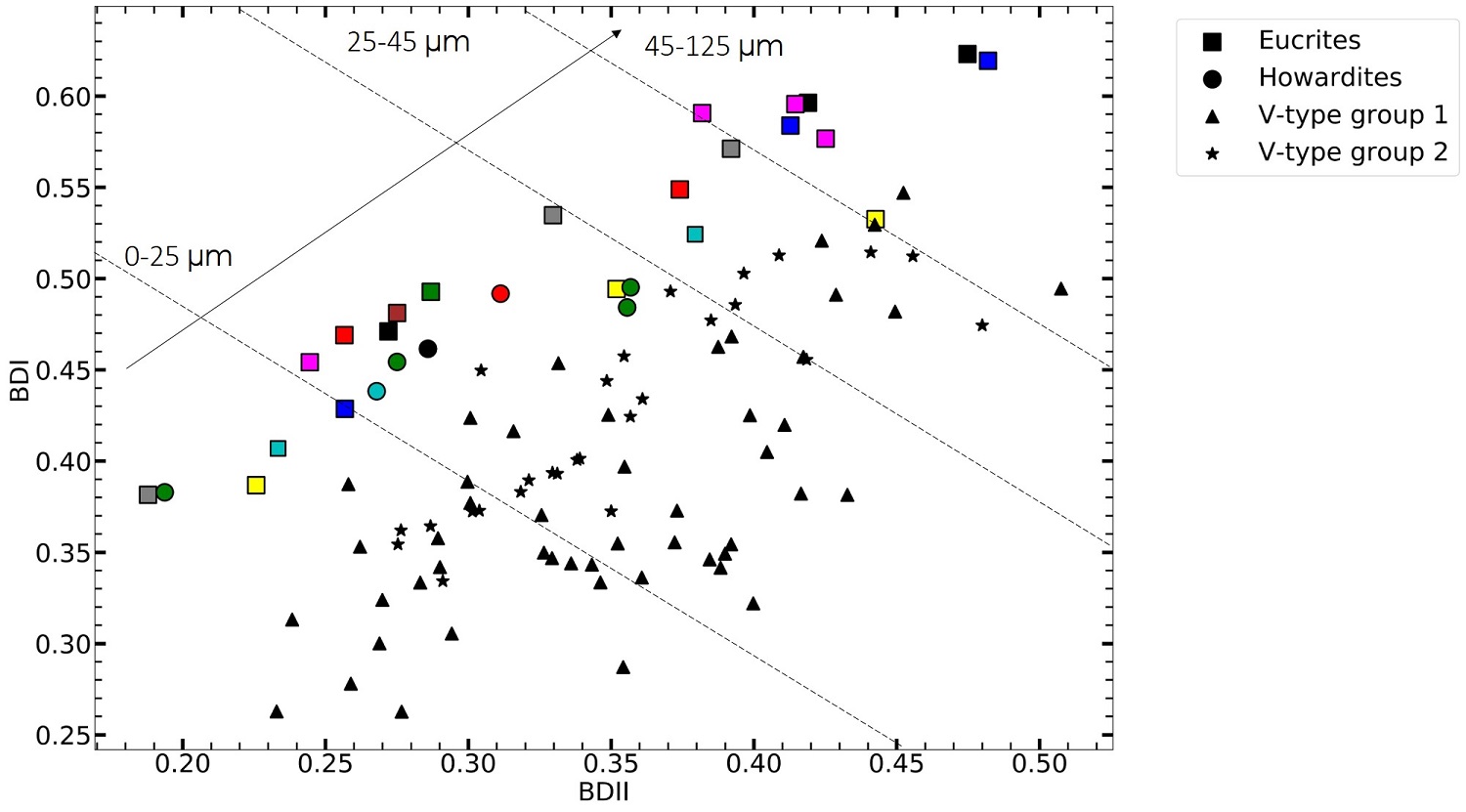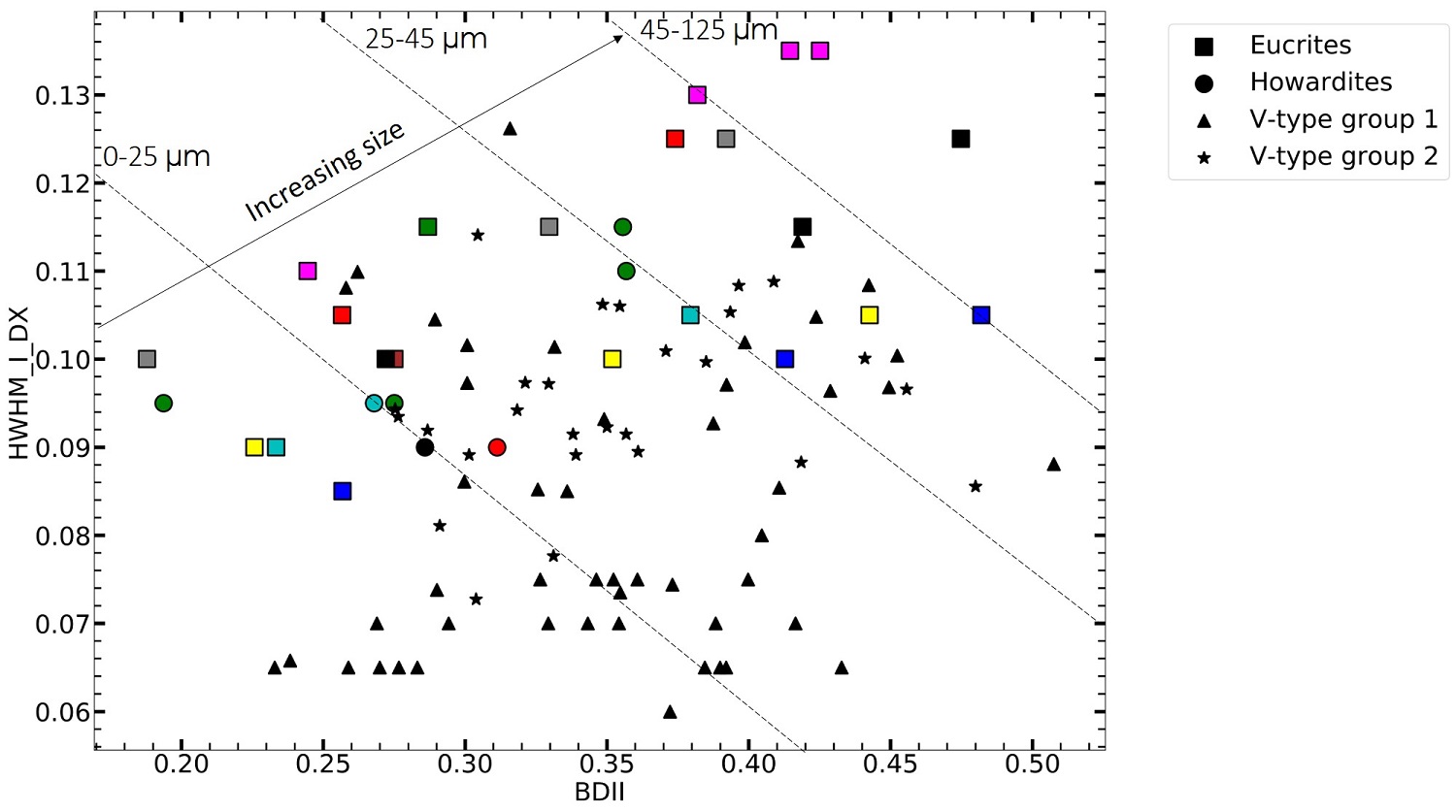Spectral properties of V-type asteroids
- IAPS-INAF, IAPS, Rome, Italy (andrea.longobardo@iaps.inaf.it)
1. Introduction
(4) Vesta is the second most massive body in the main asteroid belt and exhibits absorption features indicative of basaltic minerals [1]. The discovery of new basaltic objects taxonomically classified as V-type asteroids [2] is probably linked to the fragments produced during a catastrophic event where Vesta is believed to have lost about one percent of its mass less than a billion years ago.
VIR spectra of Vesta’s and V-type asteroids surface show absorption bands centred at approximately 0.9 and 1.9µm, confirming the pyroxenes presence [1] and they have a reflectance spectrum which is very similar to HED.
We aim to infer the modal mineralogical compositions and regolith grain size of some V-type asteroids using the Hapke radiative transfer model, basing on the results of scatterplot analysis of spectral parameters such as Band Center I (hereafter BCI) and Band Center II (hereafter BCII), Band depth (hereafter BDI) and Band depth II (hereafter BDII) and Half-width-half-maximum (hereafter HWHM). It is also foreseen to test the genetic linkages between V-type asteroids and HED meteorites and Vesta.
2. Data and method
We analysed 76 V-type asteroids normalized spectra in the infrared from 0.7-0.8 µm to 2.5 µm, divided in two datasets. The first group was from [3] and the second was from [4, 5, 6]. All the spectra were downloaded from the Planetary Data System (PDS).
To study the spectral properties and to understand the mineral composition and possibly the physical characteristics of the regolith (i.e., effective grain size), we introduced spectral parameters such as the band BC, BD and HWHM as defined in [7] and compared the results obtained from V-type asteroid with HED meteorites used in [7]. We also applied Hapke’s bidirectional reflectance model to retrieve compositional and grain size information for the V-type asteroids and HED analysed in this work.
The whole procedure can be schematized as follows:
- Retrieve the mineralogy of each V-type asteroid dataset, by comparing them with HED in BCI versus BCII scatterplot (Figure 1)
- Retrieve the grain size regolith range of each V-type asteroid dataset, by comparing them with HED in BDI versus BDII and HWHM I dx versus BDII scatterplot (Figure 2, Figure 3)
- Application of the Hapke’s bidirectional reflectance model to the spectral deconvolution of the selected asteroids and meteorites.
The used end-members in the Hapke retrieval are clinopyroxene, orthopyroxene and plagioclase [8]. We assume that the scattering is isotropic and no backscattering is considered.
In order to simulate HED mineralogy, abundance limits on fractional mass of pyroxene (40% to 100%) and of plagioclase (0% to 60 %) were set in the Hapke retrieval.
In addition, the grain size for each mixture was varied (in step of 5 µm) from 5 µm up to a limit of 80 µm, in agreement with scatterplot analysis (Figure 2, Figure 3).

Figure 1: Band I Center versus Band II Center scatterplot of HED and V-type group 1 and group 2. For the entire legend see [9] .

Figure 2: BDI versus BDII scatterplot on Eucrite, Howardite and V-type group 1 and group 2.

Figure 3: HWHM I DX vs BDII scatterplot on Eucrite, Howardite and V-type group 1 and group 2.
3. Results and conclusions
Through the scatterplot analysis (Figure 1) we observed that the asteroids have the same mineralogy of HED (same trend line) and an upper limit of grain size of 80 µm. Basing on these results, we applied Hapke retrieval on asteroid sample using the main endmembers of HED (plagioclase, clinopyroxene and orthopyroxene) and a fixed grain size range (Figure 2, Figure 3) to simulate spectra. In order to find the best fit, a R2 statistical test was performed.
Hapke procedure tested on HED spectra with known composition from [8] gave a global R2 with a mean value of 0.92. The 86 % of grain size, resulting from Hapke model on HED (with known and unknown composition [8]), lied in the declared range .
The Hapke procedure on asteroids sample had a R2 mean value of 0.97, in addition a mean grain size of ≈20 µm is given. This is in agreement with previous analyses.
So, our Hapke implementation, basing on the results of scatterplot analysis, is able to reproduce the spectral shapes and absorption features for all the V-type asteroids examined here, providing a globally satisfactory fit, confirming a link between V-type asteroids, HED meteorites and Vesta.
References
|
[1] |
M. C. De Sanctis, Meteoritics & Planetary Science 48, n. Nr 11, p. 2166–2184, 2013. |
|
[2] |
F. E. DeMeo, Icarus 202, p. 160–180, 2009. |
|
[3] |
N. A. Moskovitz, Icarus 208, p. 773–788, 2010. |
|
[4] |
P. S. Hardersen, «,» The Astronomical Journal, 156:11, p. 16, 2018. |
|
[5] |
P. S. Hardersen, The Astrophysical Journal Supplement Series, 221:19, p. 12, 2015. |
|
[6] |
P. S. Hardersen, Icarus 242, p. 269–282, 2014. |
|
[7] |
E. Palomba, Icarus 240, p. 58–72, 2014. |
|
[8] |
D. W. Mittlefehldt, Chemie der Erde 75, pp. 155-183, 2015. |
|
[9] |
M. Angrisani, «Master degree thesis,» Università Federico II, 2021. |
How to cite: Angrisani, M., Palomba, E., Longobardo, A., Raponi, A., and Dirri, F.: Spectral properties of V-type asteroids, Europlanet Science Congress 2021, online, 13–24 Sep 2021, EPSC2021-357, https://doi.org/10.5194/epsc2021-357, 2021.

